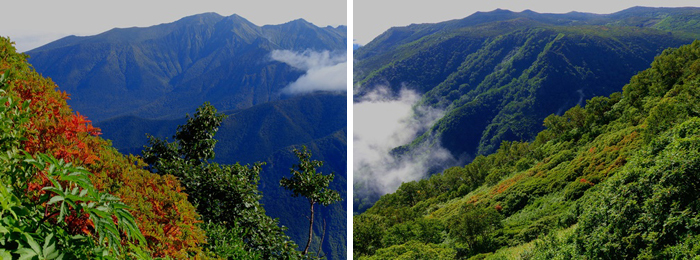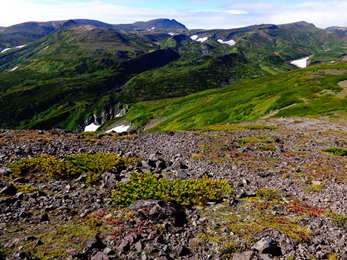The fall foliage season has arrived. But that doesn’t mean you have to rush out to see it.
Generally speaking, most of the leaves are still green. However, the Arctous alpinus var.
japonicus are approaching their best season in some areas, although their leaves remain green in others.
Last year, I declared the start of the season in this blog on August 22nd.
Judged on a day-by-day basis only, it appears that this year the season has started at roughly the same time as last year. However, when I looked at the Arctous alpinus var. japonicus, I found that their leaves had already turned red due to the wide temperature differences we had in early August.
This is very early, so I kept an eye on the situation.
My next report was on August 19th of this month. In it, I said that the coloring Arctous alpinus var. japonicus leaves had spread even further, and that their color had deepened. I continued to watch the situation.
And now it’s already the 25th. The coloring leaves have spread even further since my last report.
Moreover, in some places, the Sorbus matsumurana, Sieversia pentapetala, and other grasses have begun to turn. Given this, I decided to declare the start of the season today.
The coloring is progressing about 10 days earlier than last year (at least as of today), and about one week earlier than in average years.
Whether it continues at this pace or temporarily stops will largely depend on the weather, which makes predictions difficult. (This has been particularly true over the past few years, as the weather has been very unstable.)
I should mention that last year the temperature fell rapidly into the first half of September, and that the best viewing season began on September 7th (Mt. Kurodake).
So, how will this year’s fall foliage season play out?
Depending on the place, it appears that the season is developing in a slightly different manner this year.
I plan to go up to Mt. Midori and Mt. Aka in the days ahead, so look for my reports on those areas, too.
For mountain information, see: http://sounkyovc.net/trails/kuro/140825kuro.pdf
*The Akaishi River is slightly high but crossable. Additionally, the snowy gorge below the Mt.Hokuchindake junction has melted.
Photos: The Sorbus matsumurana are turning slightly near the 9th Station (left). A look into the stream from near the 9th Station revealed that there is some slight coloring there (center). The slopes along the Akaishi River have started to turn (right). Aug. 25
Generally speaking, most of the leaves are still green. However, the Arctous alpinus var.
japonicus are approaching their best season in some areas, although their leaves remain green in others.
Last year, I declared the start of the season in this blog on August 22nd.
Judged on a day-by-day basis only, it appears that this year the season has started at roughly the same time as last year. However, when I looked at the Arctous alpinus var. japonicus, I found that their leaves had already turned red due to the wide temperature differences we had in early August.
This is very early, so I kept an eye on the situation.
My next report was on August 19th of this month. In it, I said that the coloring Arctous alpinus var. japonicus leaves had spread even further, and that their color had deepened. I continued to watch the situation.
And now it’s already the 25th. The coloring leaves have spread even further since my last report.
Moreover, in some places, the Sorbus matsumurana, Sieversia pentapetala, and other grasses have begun to turn. Given this, I decided to declare the start of the season today.
The coloring is progressing about 10 days earlier than last year (at least as of today), and about one week earlier than in average years.
Whether it continues at this pace or temporarily stops will largely depend on the weather, which makes predictions difficult. (This has been particularly true over the past few years, as the weather has been very unstable.)
I should mention that last year the temperature fell rapidly into the first half of September, and that the best viewing season began on September 7th (Mt. Kurodake).
So, how will this year’s fall foliage season play out?
Depending on the place, it appears that the season is developing in a slightly different manner this year.
I plan to go up to Mt. Midori and Mt. Aka in the days ahead, so look for my reports on those areas, too.
For mountain information, see: http://sounkyovc.net/trails/kuro/140825kuro.pdf
*The Akaishi River is slightly high but crossable. Additionally, the snowy gorge below the Mt.Hokuchindake junction has melted.
Photos: The Sorbus matsumurana are turning slightly near the 9th Station (left). A look into the stream from near the 9th Station revealed that there is some slight coloring there (center). The slopes along the Akaishi River have started to turn (right). Aug. 25

